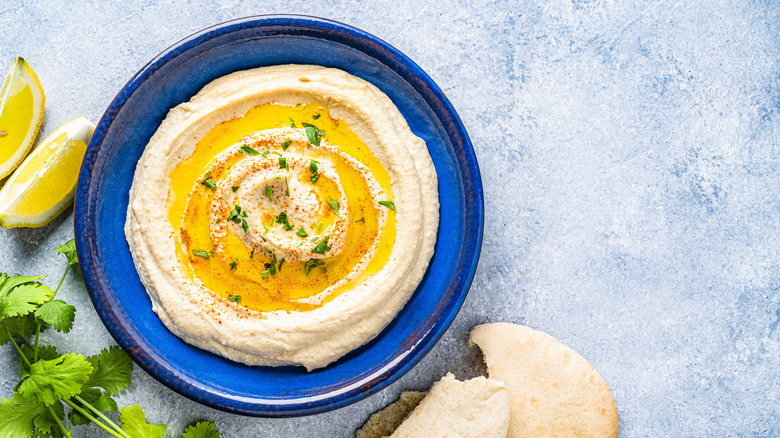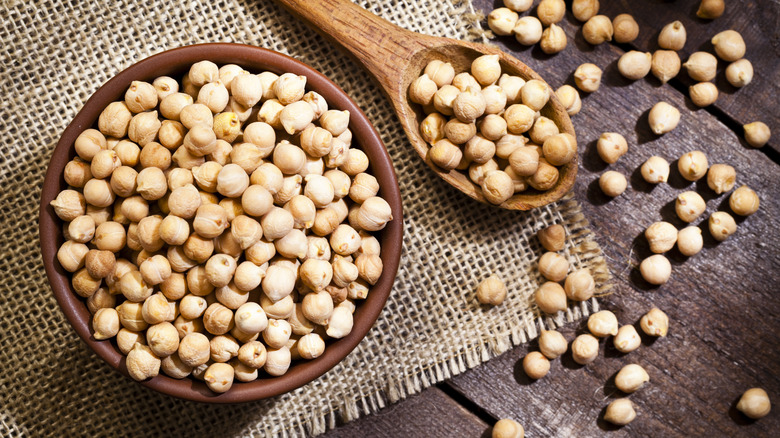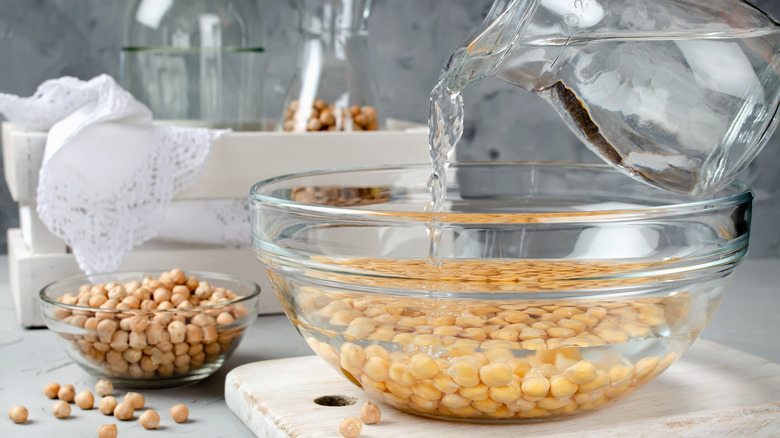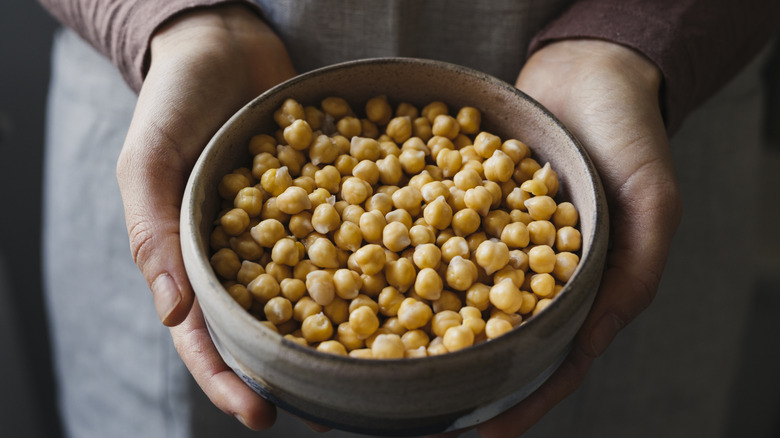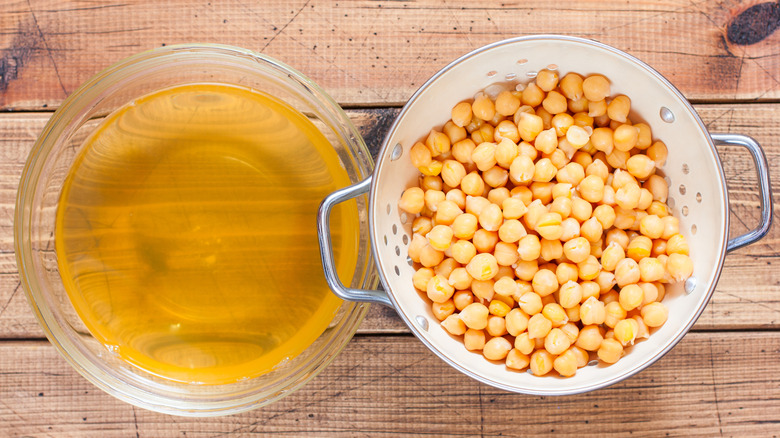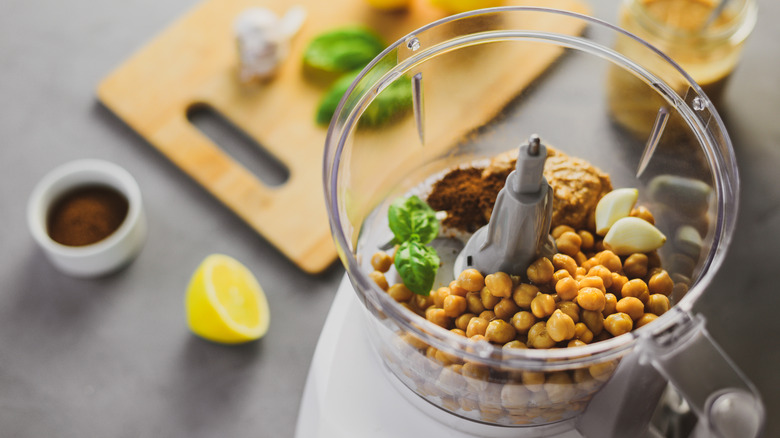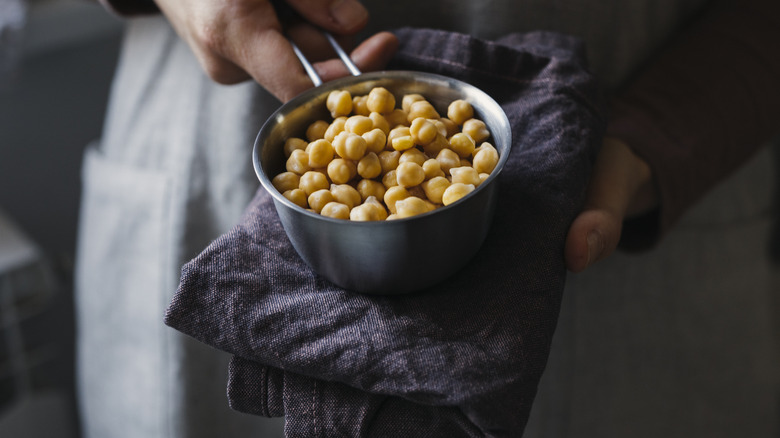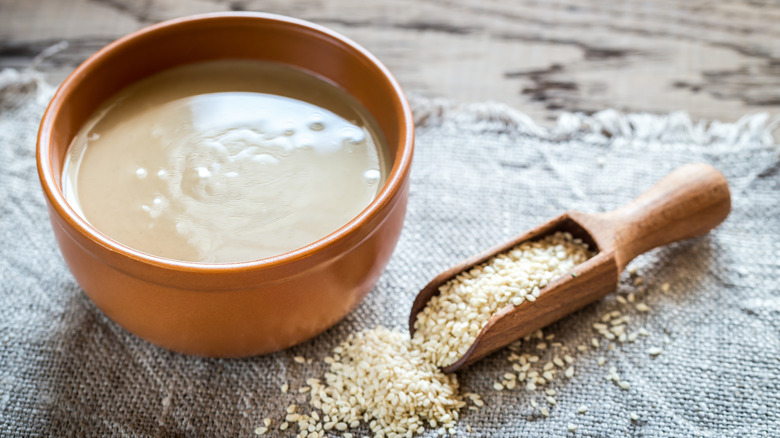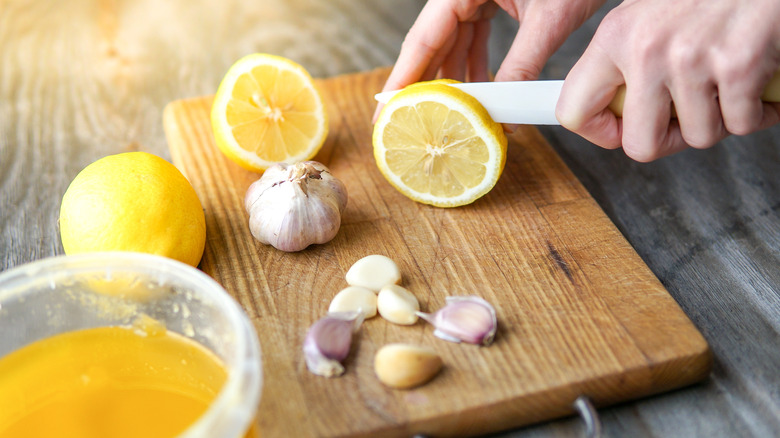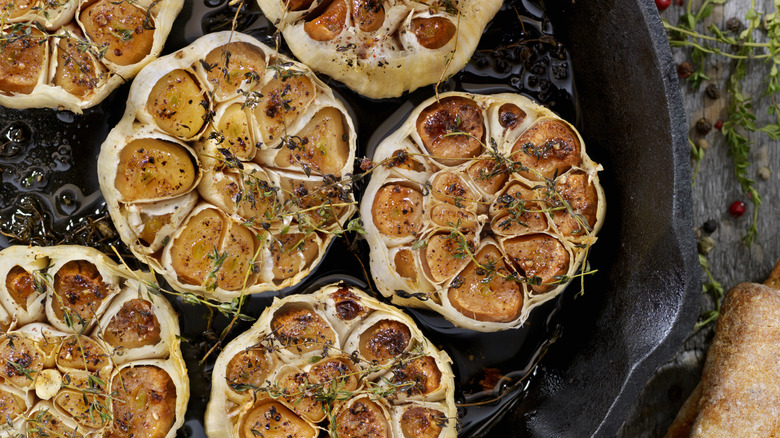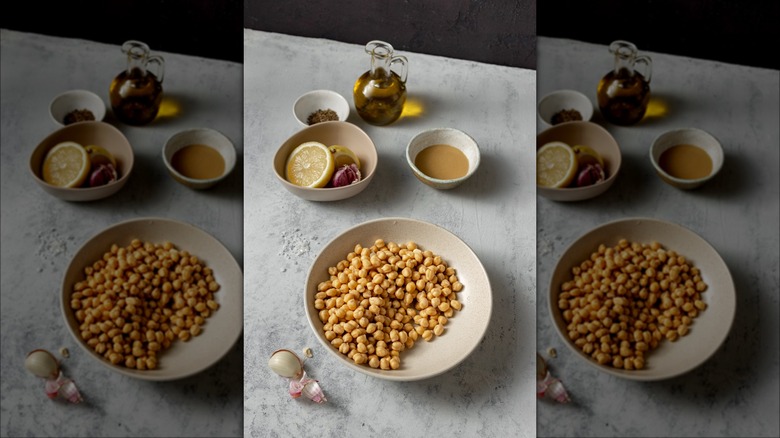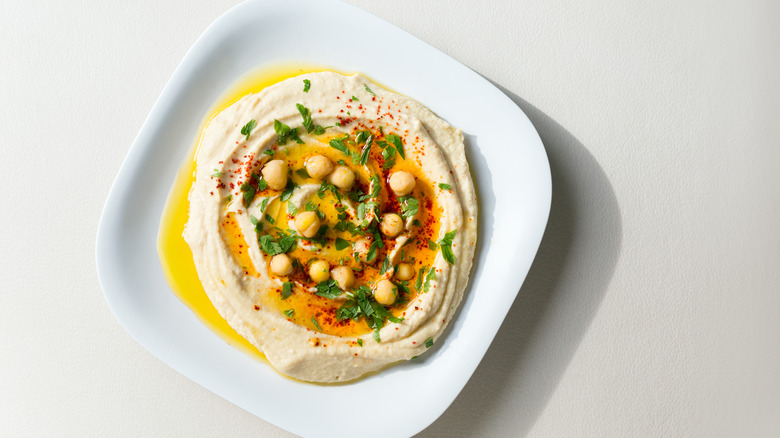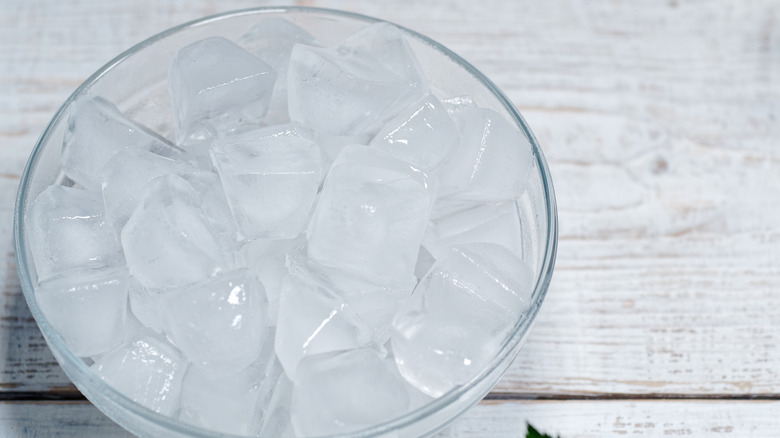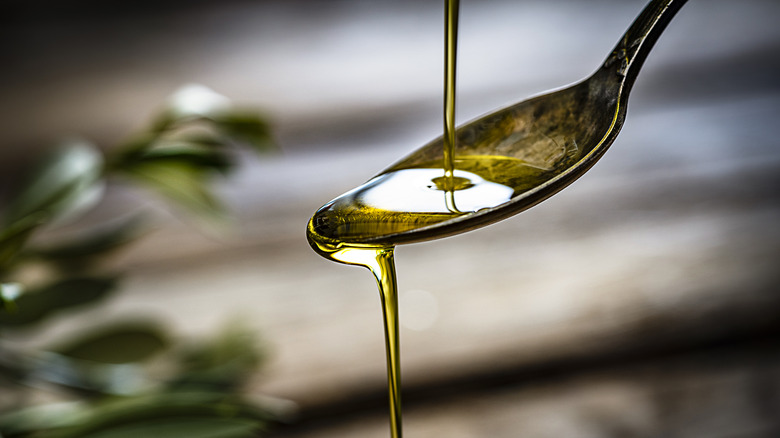13 Expert-Approved Hummus Tips You'll Wish You Knew Sooner
Hummus contains just a handful of simple ingredients, so why is it easy to get wrong? If you've ever attempted to throw together some homemade hummus only to find the result grainy, stodgy, or tasteless, you need help. Luckily for you, we've collected 13 tips for making the perfect hummus that you'll wish you knew sooner.
There's lots to unpack when it comes to the perfect hummus. It hails from the Middle East, which means there are many regional variations to contend with. And, then there's individual preference. Some people love perfectly smooth hummus, while others prefer a bit of texture. Some enjoy plenty of the intense flavor that comes from tahini, while others like to mostly taste chickpea. Bearing these factors in mind, we've got all the tips you need, including how to make smoother hummus and avoid too much of a punch from garlic.
I have eaten — and made — vast quantities of hummus in my time, and I have opinions. However, I wanted to hear from the experts. So, I spoke to three chefs, all with extensive experience in Middle Eastern food. Their expertise will help you get the perfect hummus you crave. And, if all else fails, you can fall back on upgrading store-bought hummus.
1. Cook chickpeas from scratch, if you have the time
Many hummus purists say your chickpeas should be cooked from scratch rather than coming from a can. While some cite the smell and flavor of canned chickpeas as the problem, the majority talk about texture. The problem is that many canned chickpeas are on the small side and slightly undercooked. What you really need for hummus is chickpeas that are plump and well-cooked, on the verge of falling apart.
Chef Sahil Sethi, culinary director of Middle Eastern restaurant Sifr, says you should first "soak them overnight at least 12 hours so they hydrate properly, then cook them in a pressure cooker or a sauce pot." He advises to "cook them a little longer so they almost are mushy." This gives them the melt-in-the-mouth consistency that makes great hummus. We'd particularly recommend cooking your own chickpeas if you like perfectly smooth hummus, rather than hummus that has some texture to it.
2. Use baking soda to make chickpeas tender
Have you ever simmered dried chickpeas for hours, only to find them still undercooked and chalky inside? Chickpeas can take notoriously long to cook perfectly, but there's one way to speed this up — using baking soda.
Before cooking chickpeas "soak them overnight with a teaspoon of baking soda to tenderize them," advises Lior Lev Sercarz, owner of spice brand La Boîte, author of A Middle Eastern Pantry, and chef at Spice Brothers. "The next day, rinse them and cook them in water with a teaspoon of baking soda," he adds. He says you should "cook them until they are very tender." Sahil Sethi also advises soaking chickpeas in baking soda before cooking. The science behind this is that baking soda creates an alkaline environment that helps to break down the pectin in the cell walls of the chickpeas, thereby softening them.
Elizabeth Mehditach, the founder and executive chef of Middle Eastern catering company and lifestyle brand LĒZA, agrees with the baking soda but says you don't need to cook chickpeas from scratch. She suggests starting with canned chickpeas and "soaking them in water with a teaspoon of baking soda (per 15-ounce can, or so) for 18 hours in the fridge." She says that this has the desired softening effect, without the hassle of cooking chickpeas.
3. If you use canned or jarred chickpeas, pay attention to quality
Yes, cooking dried chickpeas will give you the best hummus — "But, please, who has time, or the patience for that," remarks Elizabeth Mehditach. We know that most people reading this just aren't going to want to involve that extra step in the process, and that's okay. You can still make very good hummus from canned or jarred chickpeas. However, you should pay attention to the quality of the chickpeas you buy.
So, what should you look for? "Look for a quality brand," says Mehditach. "An international company like Sadaf or Golchin are always trustworthy," she adds. What's more, she says you should "stay away from generic grocery store labels — they tend to be smaller in size and not good quality. She also notes, as a reminder, that chickpeas and garbanzo beans are the same thing by different names. So don't be surprised if you're looking for chickpeas and only spot garbanzo beans, or vice-versa.
But, everyone has their own preferences. "I like to use organic canned chickpeas and make sure I rinse them well before making hummus," says Lior Lev Sercarz. Sahil Sethi, on the other hand, recommends no salt canned chickpeas from Whole Foods. If you can find jars of chickpeas, they tend to be larger and softer than canned varieties — though they're usually significantly more expensive.
4. Save the liquid from the can
If you're using canned chickpeas, you'll probably drain the liquid right down the sink. However, Elizabeth Mehditach notes, "When draining chickpeas, always save the liquid to use when making the hummus." She says, "You won't use all of it, but it adds flavor to the emulsification." Although we're talking about canned beans here if you cook your chickpeas from scratch, you can save some of the cooking liquid and it will have the same effect.
In some circles, this chickpea liquid is known as aquafaba. Due to the proteins it contains, it has the strange ability to whip up like egg whites and is often used to make vegan meringue. While meringue and hummus are two very different things, we can see how this might add a certain lightness to hummus that plain water wouldn't bring. Plus, it has the bonus of being full of chickpea flavor. That said, if your chickpeas come in salted water, you may need to slightly adjust the quantity of salt in your hummus recipe.
5. Consider using warm chickpeas
When you're cooking chickpeas from dried, you might assume you need to cool them before you start to make your hummus. However, Lior Lev Sercarz says, "If you are planning to serve the hummus right away, you can make the hummus with warm chickpeas." Hummus, in fact, is traditionally served warm — or at least at room temperature, so using warm chickpeas and serving warm hummus is more than acceptable.
But, it's not just that hummus can be served warm that makes it alright to use warm chickpeas, it might actually be a benefit to the finished dish. Warm chickpeas make for smoother, creamier hummus. It's a simple way to improve the texture. So, if you're using canned chickpeas, you can even opt to warm them slightly in the microwave or in a pan on the cooktop before blending. And, if you're using chickpeas you cooked yourself, you can add some of the warm cooking liquid.
6. Peel your chickpeas
You might think we sound a bit mad if we suggest you peel your chickpeas before you make hummus, but trust us. This is a time-honored way to make that intensely smooth, creamy hummus that's the stuff of deli counters — and dreams. Sahil Sethi remarks that the chickpea skins "can be removed to make it more smooth textured."
Elizabeth Mehditach also notes removing the skins as an option for super smooth hummus. She says, "With a tea-towel or kitchen towel, gently rub the lot to remove their skins." You can do it between two tea towels, placing one on the countertop, dumping your chickpeas on top, and then using another tea towel to rub the chickpeas, which removes the skins. Another option is to put the cooked chickpeas in a bowl of water and swirl them around vigorously. This releases the skins, which float to the surface, so you can skim them off. If you don't get every skin, that's okay. Even if you get a large portion of them, it will make your hummus smoother.
You can still make good hummus without removing the skins, but it won't be as smooth. That said, some people prefer the texture that comes from the chickpea skins, finding hummus made from peeled chickpeas overly smooth. So, if your preference is for a chunkier hummus, you might want to ignore this tip.
7. Choose the right tahini
All hummus needs tahini. If you're wondering, what is tahini? Well, it's simply a paste made from sesame seeds — a bit like a sesame version of natural peanut butter. However, it isn't as simple as just grabbing some tahini. There are two main varieties: hulled (sometimes called light tahini) and unhulled (sometimes called dark tahini).
Hulled tahini has had the seeds' outer shells removed before blending, while unhulled hasn't, which gives it a darker color. Unhulled tahini has a slight bitterness to it, which some people like, while hulled tahini is more neutral in flavor. You might also find roasted and unroasted versions of both — the roasted ones have more nuttiness to them.
So, which one is right for hummus? There's actually no consensus on this — just use whichever you like the flavor of best. Most of all, quality matters. "Amazing tahini is the key to a good hummus," says Lior Lev Sercarz. So, avoid buying grocery store tahini, where possible, and instead head to a Middle Eastern grocery store to get your stash.
8. Mix the lemon juice and garlic together
One common complaint about homemade hummus is that the garlic is excessively sharp. Although raw garlic is a traditional addition to hummus, occasionally it can have too much of a bite to it. This may vary depending on factors such as the size of the cloves used or how fresh they are. This doesn't mean you should avoid garlic — it's a vital addition to hummus — but there's a tip to help solve this dilemma without skimping on garlic.
When preparing the garlic for his hummus, Lior Lev Sercarz says, "I like to mix it well with lemon juice and let it sit for a few minutes. I find that the acidity of the lemon slightly 'cooks' the garlic and mellows the taste." After letting the garlic sit in the lemon juice for a few minutes, you can then get on with making the hummus as directed. Sahil Sethi also says you can "soak it in milk for an hour or so," though this seems like a more long-winded option — and means your hummus is no longer suitable for vegans or people with dairy allergies.
9. Consider roasted garlic
"Not a fan of raw garlic? Use roasted garlic instead," suggests Elizabeth Mehditach. Sahil Sethi also suggests roasted garlic as an option for a more muted garlic flavor. The thing about roasted garlic is that it's significantly milder and has delicious sweet notes to it. While it might not be entirely traditional, it brings a lovely depth of flavor to hummus, while avoiding any potentially harsh notes from raw garlic. We're not saying that this is always the best way to make hummus or that everyone should do it, but it's an option worth considering.
So, how do you roast garlic? Mehditach has the lowdown for us. She says you should first cut the top off the head of garlic, drizzle it with olive oil, sprinkle on some salt and pepper, and then wrap it in foil. When ready, roast it in the oven at 425 degrees Fahrenheit "for about 25 to 40 minutes." The resulting garlic is soft and spreadable, so it's easy to work with and blends seamlessly into hummus. There's no chance of encountering a pungent chunk like there is with raw garlic. Once the garlic has been roasted and cooled, Mehditach says you can "squeeze [the] desired amount into [a] processor with chickpeas and whirl away."
10. Pay attention to ingredient quality
All our experts agree that ingredient quality matters if you want to make the best possible hummus. Here's what Elizabeth Mehditach has to say about it — "Ingredient quality absolutely matters. As in all food prep and presentation. The better the quality the better the taste and the longer the shelf life. Though, hummus doesn't tend to hang around for long."
Ingredient quality is particularly pressing with hummus because it contains only a handful of simple ingredients. A basic hummus recipe contains chickpeas, tahini, garlic, and lemon juice — plus salt and water or the chickpea cooking liquid. This gives you very little room to hide. It's not like recipes where you have lots of fragrant herbs or punchy spices. Nor is it like recipes with long cooking times where the flavors meld and develop gradually. What you start with is pretty much what you end up with, just in blended form — hence the importance of flavorful ingredients.
So, while you could just go to the store and pick up whatever's on offer, it pays to choose high-quality ingredients. Go to the Middle Eastern grocery store and spend out on good tahini. Pick up that $5 jar of plump, soft chickpeas you spot at the deli. Buy a fresh head of garlic rather than using that wrinkled old clove in your pantry. The resulting hummus will be all the better for it.
11. Use the right chickpea-to-tahini ratio
When you're making hummus, it's important to think about the ratio of chickpeas to tahini that you use. Now, saying that you should use the right chickpea-to-tahini ratio is a bit misleading, because there isn't just one. We hate to break it to you, but there's no single perfect hummus recipe. There are all kinds of variations based on geography, as well as the preferences of the recipe writer. So, what you need to do is to figure out your own preferences. Yes, it will take time, but you'll get to enjoy more hummus while you figure out what you like.
According to Lior Lev Sercarz, "a 50-50 ratio between cooked chickpeas and tahini" is the way to go. Sahil Sethi, on the other hand, uses two parts chickpeas to one part tahini. Elizabeth Mehditach has yet another opinion — 1/4 to 1/3 cup of tahini for every 16-ounce can of beans. So, you see, even the experts are divided.
The more tahini you use, the more you'll taste its rich, nutty, slightly earthy flavor. It's a distinct flavor that some people love and want a lot of in their hummus, while others prefer it to take a backseat to chickpeas. Hummus that contains a lot of tahini also tends to be slightly smoother. So, think about what you like and work from there.
12. Add ice water or ice cubes
It might seem strange to add ice to your hummus — after all, it isn't a tumbler of whiskey or a Coke — but this might be the key to lighter, creamier hummus. Elizabeth Mehditach recommends adding a quarter cup of ice water to your hummus recipe. She says, "The ice is really important to add a frothy whipped consistency."
The ice is said to aerate the mixture during the blending process. And, the more air that's incorporated into the recipe, the lighter the hummus will be. This trapped air makes the hummus seem even creamier. This is a good tip to work into your repertoire if you've previously found the hummus you've made to be overly thick, heavy, or stodgy. Of course, this is at odds with the advice to blend your chickpeas while warm, so you should choose one of these tips or the other.
13. Save the olive oil for drizzling
Some hummus recipes contain olive oil — or other oils — blended into the mixture. But, there's some dispute over whether or not this is necessary. "To use or not to use, that is the question," says Elizabeth Mehditach. She's on the fence about using olive oil. "I understand in some countries of the Middle East it is common to add a good drizzle of the liquid gold," she notes, but adds, "In my opinion the tahini should provide that silken texture that the olive oil provides."
Lior Lev Sercarz agrees. "You do not need oil in hummus," he says. "Tahini has enough fat in it — save your oil for something else," he adds. However, not everyone agrees with this. You'll find plenty of hummus recipes that include olive oil in the mix. Sahil Sethi believes that regular olive oil is good for blending into hummus, while extra virgin olive oil is best drizzled over the top to finish the dish.
You might want to experiment with both versions, but olive oil might be unnecessary, especially in tahini-rich recipes. So, rather than blending olive oil into your hummus, you can save it to drizzle over the top. Mehditach has some ideas for other toppings. She likes to top her hummus with crimini sliced mushrooms sautéd in olive oil, with shallots and sherry.
